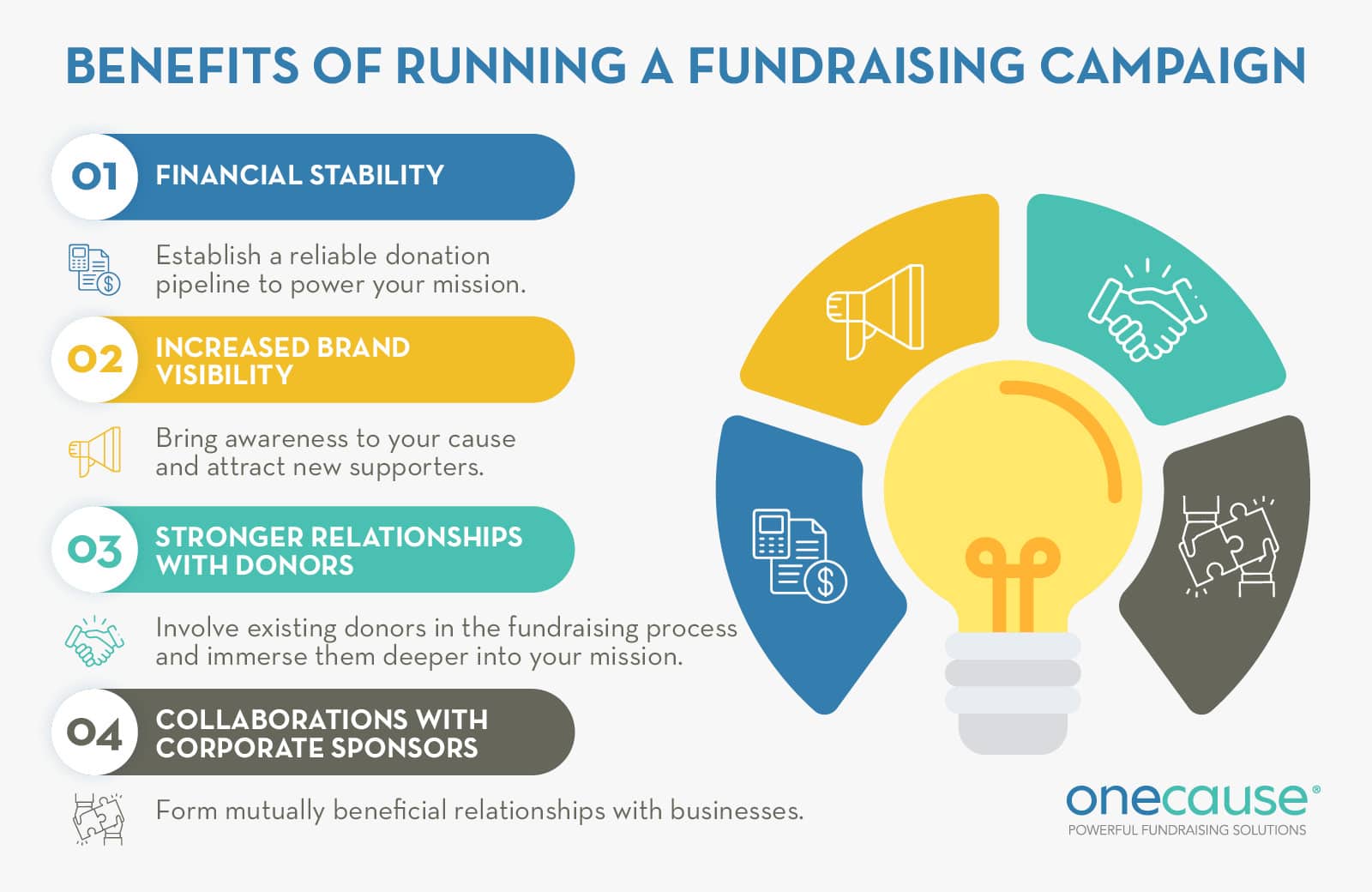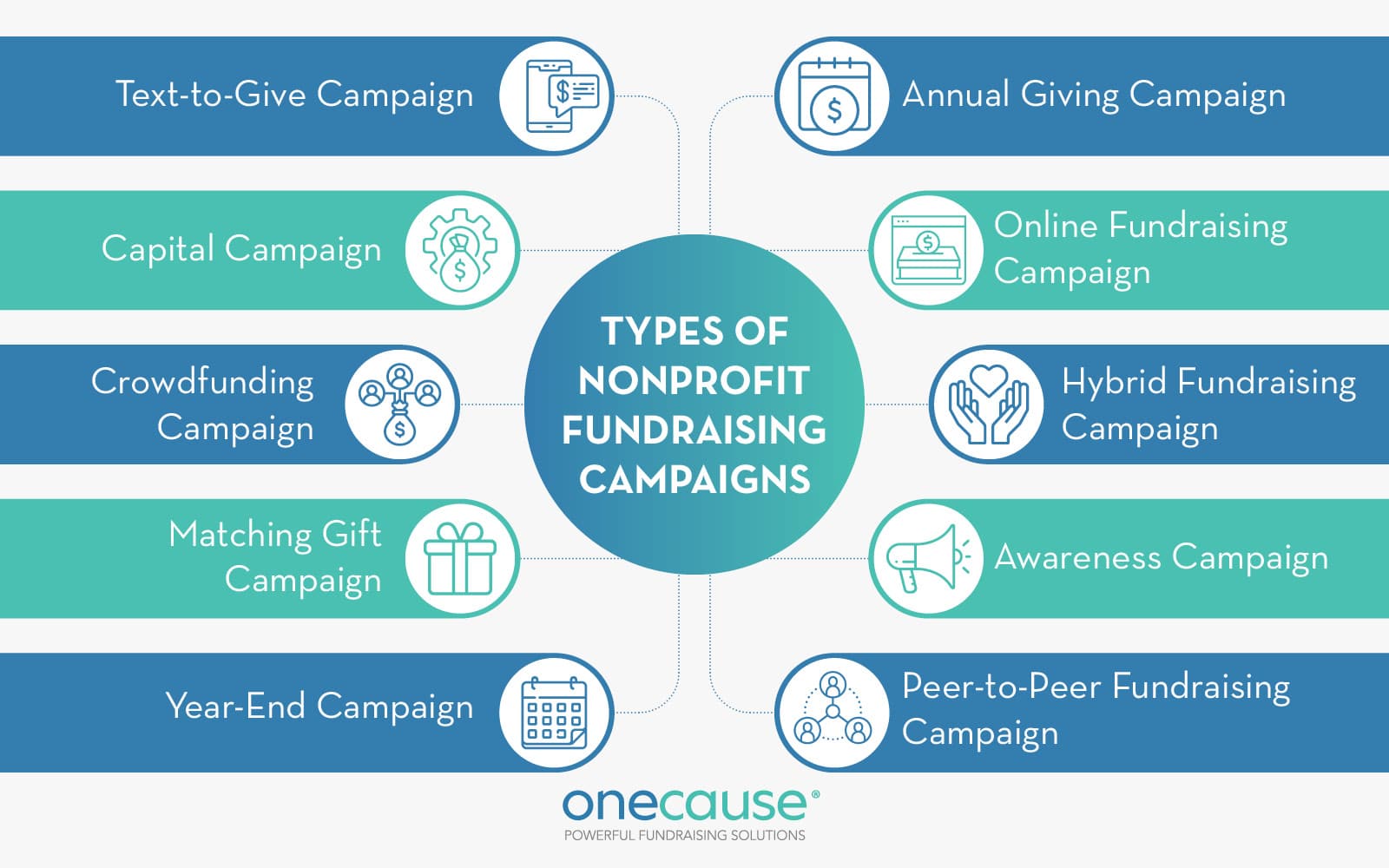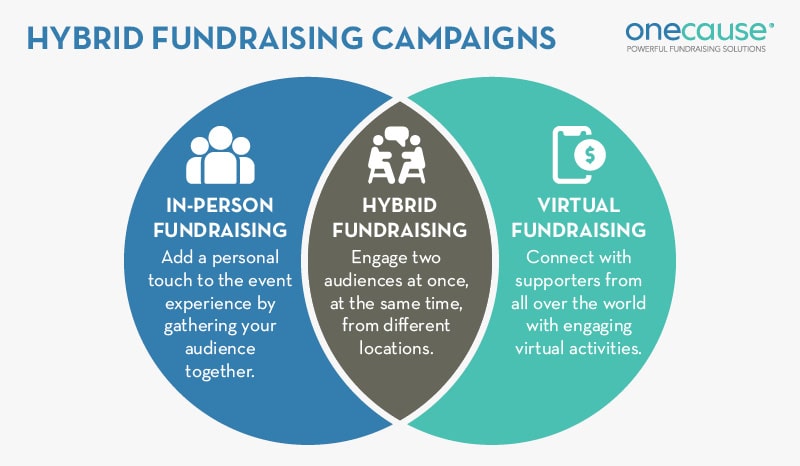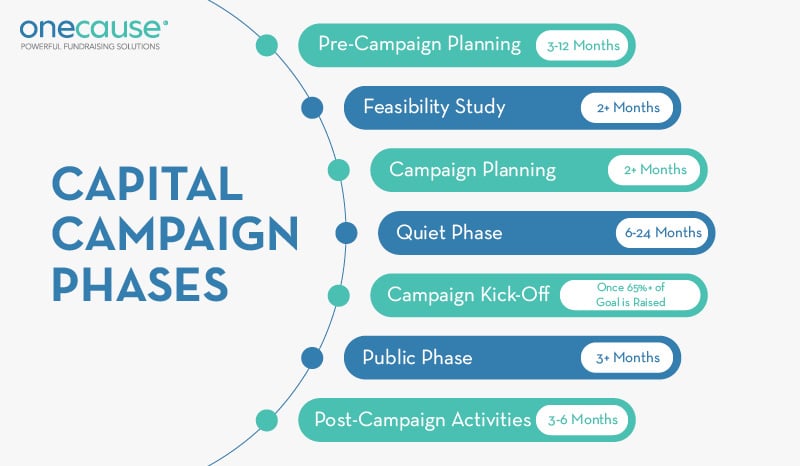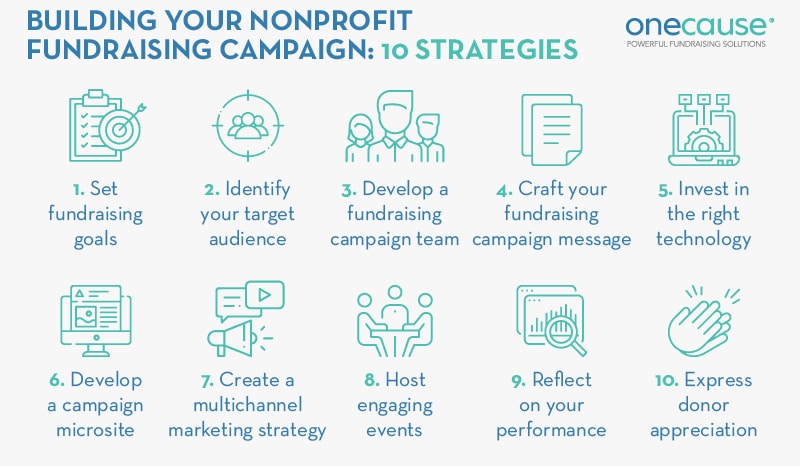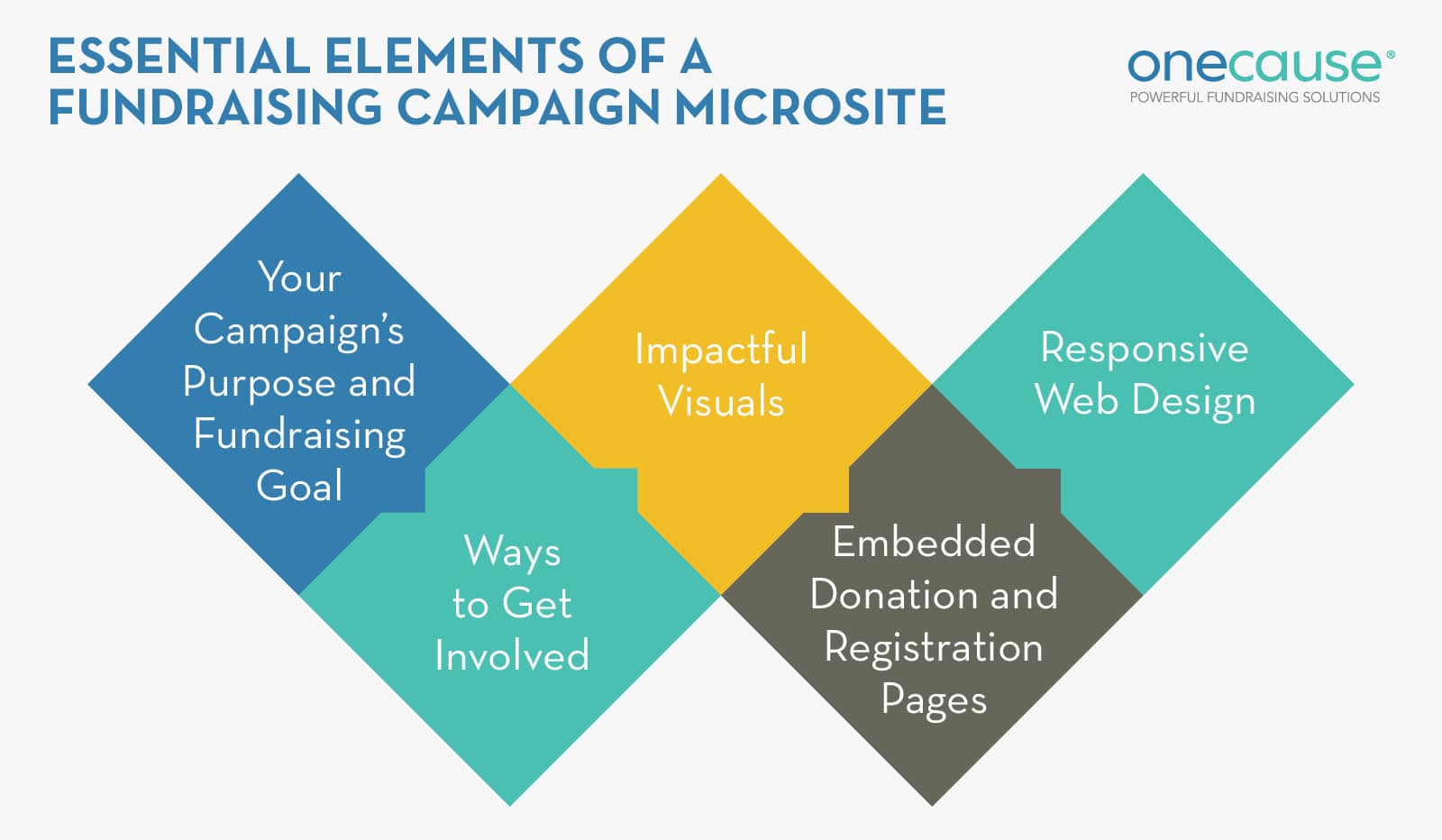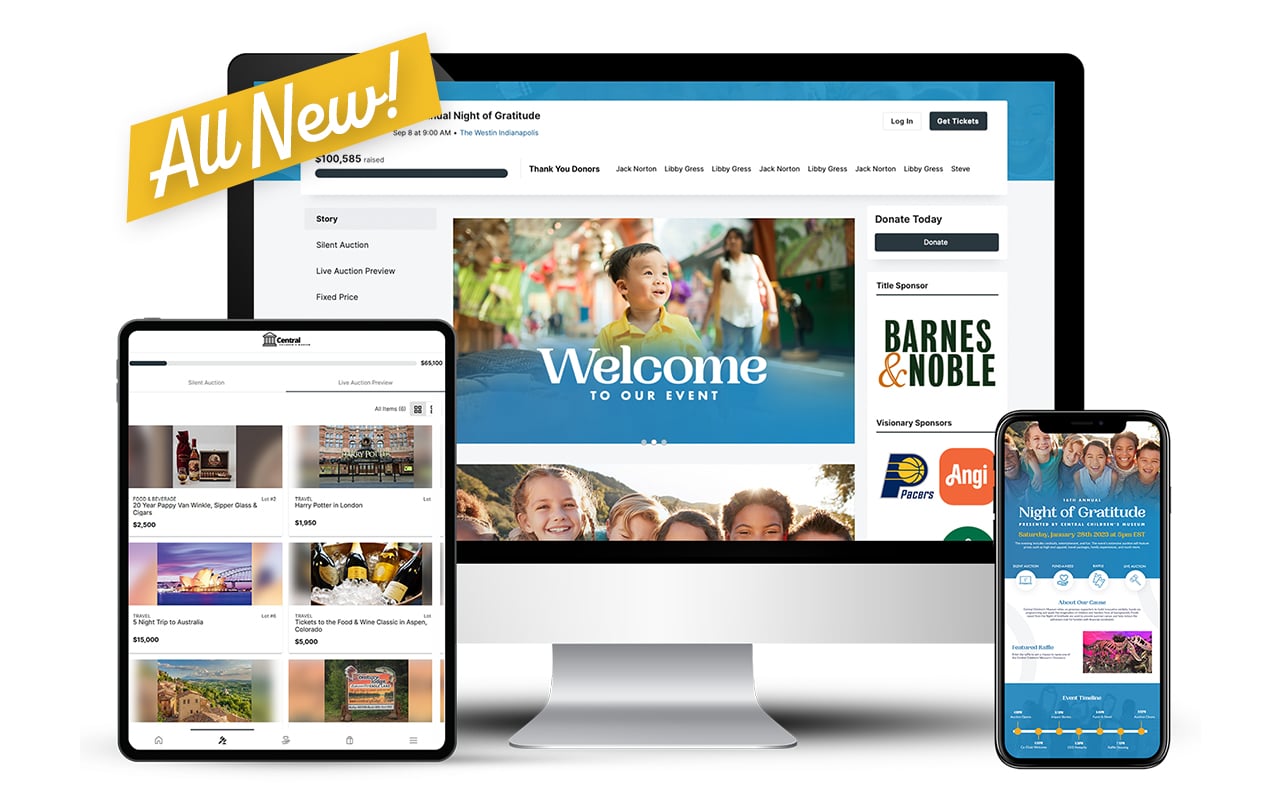Nonprofit Fundraising Campaigns: 10 Strategies for Success
To achieve your nonprofit’s ambitious goals and deepen its impact, you need consistent sources of funding. Fundraising campaigns play a crucial role in generating the necessary resources and support to power your mission. With a well-designed fundraising campaign, your nonprofit can engage potential donors, inspire giving at a large scale, and encourage supporters to play a bigger role in your organization’s success.
Best of all, the sky’s the limit when it comes to designing winning fundraising campaigns! From peer-to-peer and online fundraising to awareness campaigns, there are a variety of fundraising ideas you can customize and combine to meet your nonprofit’s specific needs. Hold a fundraising campaign of any type, at any time of the year, to supplement your annual income and bolster your donor relationships.
In this guide, we’ll go over everything your nonprofit needs to know to plan and execute a successful fundraising campaign. We’ll cover:
- Fundraising Campaign FAQs
- Types of Fundraising Campaigns
- How to Run a Fundraising Campaign: 10 Expert Strategies
Running a fundraising campaign doesn’t have to be difficult! With the right tools and strategies, your nonprofit can supercharge your fundraising strategy and advance your mission. Let’s begin!
Fundraising Campaign FAQs
Before we dive into the different types of fundraising campaigns and strategies for success, let’s make sure you’ve mastered the basics. These common FAQs will help you understand what a fundraising campaign is and how it functions as part of your larger fundraising strategy.
What is a fundraising campaign?
A fundraising campaign is a strategic effort to raise funds within a defined period of time. These funds can be used for a specific initiative or purpose, like building a new facility, or generally applied to your nonprofit’s day-to-day expenses. Campaigns can also be designed with other objectives in mind beyond raising a certain dollar amount, such as:
- Raising awareness for your cause
- Acquiring new donors
- Recruiting a certain number of peer-to-peer fundraisers
- Growing your monthly giving program
- Stewarding major donors
The type of campaign you choose to lead will depend on your objectives and what makes the most sense for your nonprofit’s current state and audience. Regardless of the fundraising campaign you decide to host, you’ll need to lay out a clear plan that covers:
- The objective of your campaign (its purpose)
- Your fundraising goal (specific dollar amount or other quantifiable metric that supports the objective)
- Target audience
- The team members (board members, staff, volunteers, ambassadors, etc.) who will contribute to your success
- Your core case for support or campaign message
- The channels you’ll use to market your campaign
- The technology you’ll use to host your campaign
- The different fundraising techniques (peer-to-peer, matching gifts, crowdfunding, etc.) you’ll leverage
- How you’ll measure and track your progress
With ample planning, you can build a custom fundraising campaign that will inspire supporters, amplify your cause, and build momentum for your mission.
Looking to dive right into fundraising campaign best practices? Navigate to our top strategies for success!
Why is it important for nonprofits to run fundraising campaigns?
Holding fundraising campaigns throughout the year can bring a number of benefits to nonprofits, including:
- Financial stability. Your nonprofit needs a reliable donation pipeline to support your programs, services, projects, and daily operations. Fundraising campaigns give you the opportunity to highlight your fundraising needs to supporters, encourage giving, and meet and surpass your fundraising goals. It’s not just about keeping the lights on! With a consistent flow of revenue, you can make progress towards your mission and create room in your budget to pursue new or expanded projects.
- Increased brand visibility. Fundraising campaigns can help you grab the attention of prospective supporters and introduce them to your organization. For example, if you’re hosting a peer-to-peer fundraising campaign and a well-connected volunteer shares their campaign page on social media, you’ve successfully reached an expansive audience who may not have known about you before! The best part? They may even be inspired to donate.
- Stronger relationships with donors. Along with connecting with new supporters, fundraising campaigns are a prime opportunity to forge stronger connections with existing supporters and immerse them deeper into your mission. Involve existing donors in your campaign by inviting them to give feedback before your campaign goes live, donate to push your fundraising goals forward, or volunteer to help plan and lead your campaign.
- Collaborations with corporate sponsors. Form the building blocks of a strong corporate partnership by asking businesses to sponsor your fundraising campaigns. This can come in the form of direct financial support, in-kind donations of goods or services, matching gifts, or another critical type of support depending on your goals. Once your campaign is over, you can strengthen this relationship and count on your partner to support your organization again in the future.
A fundraising campaign also gives you the opportunity to rally your team around your nonprofit’s guiding principles and plan activities that will put your mission into action. By working together to lead a winning campaign, your team of volunteers and staff will feel more invested in your organization and eager to see your goals through.
When should my nonprofit run a fundraising campaign?
Your nonprofit can host a fundraising campaign at any point in the year depending on your specific needs and goals. However, many nonprofits will plan fundraising campaigns around certain occasions, such as:
- Secular holidays. Many nonprofits host fundraising campaigns around major holidays that relate to their mission. For instance, Earth Day inspires thousands of environmental organizations to lead fundraising campaigns in April while the environment is top-of-mind for many.
- Awareness days and months. There are plenty of awareness days and months that draw public attention to important causes, issues, and topics, from Breast Cancer Awareness Month to World Mental Health Day. Consider aligning your fundraising campaign with an awareness day or month that ties back to your cause.
- Year-end giving season. December sees 30% of all annual giving, with 10% of all donations occurring during the last 3 days of the year alone. But that doesn’t mean your nonprofit should wait to launch its campaign in the last week of the year! A year-end fundraising campaign should begin in November, with some nonprofits starting as early as September.
- Milestones or anniversaries. Celebrate milestone events and anniversaries with your entire community by reminding supporters of the important work they’ve helped you accomplish and requesting donations to fuel your ongoing progress.
- Unexpected events. Natural disasters, economic uncertainties, and policy changes can all prompt nonprofits to take action and ask for funds. For instance, a disaster relief organization might host a time-sensitive fundraising campaign after a major hurricane or tornado. These types of campaigns leverage public concern to bring in as much national or global support as possible for a pressing issue.
While grounding your campaign in a certain time of the year can help capitalize on increased public awareness and willingness to give, your nonprofit doesn’t always need a special occasion to lead a successful fundraiser! With the right amount of planning and a compelling case for support, you can bring attention to any fundraising campaign and inspire your community to push your goals forward.
Types of Fundraising Campaigns
Now that you know the ins and outs of fundraising campaigns, it’s time to consider the different types of fundraising campaigns you can add to your fundraising calendar. There are a variety of fundraisers you can lead to take your mission to the next level, including:
1. Annual Giving Campaign
Annual giving campaigns are fundraising initiatives designed to establish a predictable flow of unrestricted revenue to cover your nonprofit’s yearly expenses. From powering your day-to-day costs to funding new technology and infrastructure investments, annual giving campaigns are necessary to keep your nonprofit afloat. These campaigns are hosted regularly throughout the year and can take many different shapes and forms.
Annual campaigns are also a great opportunity to engage closely with existing donors. With a strong donor stewardship strategy, you can successfully move donors up the donor pyramid to higher-impact gifts with each new annual campaign. In preparation for your annual campaigns, be sure to send personalized donation requests based on donors’ motivators and past giving behavior and explain how their increased generosity will fuel your mission.
2. Online Fundraising Campaign
An online fundraising campaign takes the entire donation process online, making the giving process more convenient for your nonprofit and its supporters. This modern approach to raising funds can help your organization reach donors from all over the world and maximize giving. To get the word out about your online campaign, optimize your online donation page, lead a robust multichannel marketing strategy, and attach exciting online events and challenges to your campaign!
For example, you might host a high-energy virtual auction, lead a virtual fitness challenge, or punctuate your event with a virtual gala. The options are endless! To streamline your online campaign planning, work with tools like a comprehensive fundraising platform and CRM.
3. Hybrid Fundraising Campaign
A hybrid fundraising campaign combines the best of both worlds of in-person and online fundraising.
With careful coordination and an engaging program lineup, you can successfully connect with two audiences at once and turn casual donors into avid supporters of your cause. Best of all, hybrid fundraising campaigns are inherently flexible and can be adapted to fit your goals and budget.
For example, if your hybrid fundraising budget is limited, you might keep your in-person component more intimate to save funds. Consider inviting only your VIP supporters (major donors, ticketed guests, board members, etc.) to an in-person auction, gala, or other lively event, then livestream the experience to remote supporters so they can get in on the action from anywhere in the world.
4. Awareness Campaign
Awareness campaigns are designed to raise awareness around an issue, bring more exposure to your cause, and grow your supporter network. While raising funds is an important part of any fundraising campaign, this type of campaign focuses more on attracting public interest and immersing prospective donors and volunteers into your mission. To gather as much public attention as possible, many nonprofits will host awareness campaigns around national awareness months that relate to their mission.
For example, breast cancer nonprofits commonly host awareness campaigns during Breast Cancer Awareness Month in October. However, you can launch an awareness campaign at any time when you want to grow your audience! Leverage social media, viral challenges, and multichannel marketing to attract people to your campaign and expand your support base.
5. Peer-to-Peer Fundraising Campaign
Peer-to-peer fundraising hands the reins over to your supporters. Through this powerful type of fundraising, your supporters will create their own fundraising pages, set individual goals, and market their campaigns widely among their personal networks. With over 23% of U.S. adults identifying as social donors in 2023, peer-to-peer fundraising stands out as one of the best ways to immerse supporters deeper into your mission!
By empowering your loyal supporters to take charge of the fundraising process, your nonprofit will expand its reach, bring in more revenue, and develop stronger relationships with your peer-to-peer volunteers.
If you’re looking to take your peer-to-peer fundraising campaign a step further, you might also lead an ambassador campaign. An ambassador campaign taps your most well-connected and influential supporters to fundraise leading up to a big event, like an auction, gala, or golf outing. Look for ambassadors among your board members, volunteers, sponsor connections and networks, and event committee members.
6. Text-to-Give Campaign
Conducted solely over text messaging, a text-to-give campaign is convenient, user-friendly, and widely accessible to all of your supporters, even if they’re miles away! Your donors will simply text a keyword to your designated short- or long-code, automatically opting them into your text messaging campaign where they’ll receive a link to your mobile-friendly donation page.
Run a text-to-give campaign at any time of the year to support your annual fund, or tie your campaign to a specific fundraising initiative. To launch your text-to-give campaign, look for a dedicated text-to-give solution with these key capabilities:
- Interactive scoreboard to display progress
- Seamless donor data collection
- Automated email receipts
- Flexible payment options
- Secure payment processing with full PCI compliance
The right text-to-give service will make it easy to lead any fundraising campaign and connect with supporters near and far.
7. Capital Campaign
Capital campaigns help raise significant funds for high-cost strategic initiatives, such as building a new facility or purchasing new equipment. These campaigns are intense undertakings that require more planning than the average fundraising campaign and can take multiple years. A capital campaign consists of the following key stages:
- Pre-campaign planning. Before you jump into your campaign, you need to take time to identify the problem your organization is facing, break down the details of your proposed solution, and lay out the benefits of this solution. At this early stage, you can create a rough case for support, which will help your leaders think through your proposed solution.
- Feasibility study. During a feasibility study, your nonprofit will conduct interviews with your key stakeholders, including your board members, staff and veteran volunteers, and major donors. These interviews give you invaluable insight into whether you have the foundational support needed to take your campaign live. Plus, feedback from your stakeholders can help reveal areas of improvement in your capital campaign and organization overall, allowing you to strengthen your fundraising strategy.
- Campaign planning. At this stage, you’ll incorporate the suggested changes from your feasibility study interviews into your campaign plan and finalize campaign details. This should include the timeline for your campaign plan, fundraising goal, campaign budget, gift range chart, and communication and marketing strategies you’ll use to get the word out about your campaign.
- Quiet phase. The quiet phase is the first step in taking your capital campaign live, but is less publicized than the later public phase. Rather than asking for donations from all your supporters, the quiet phase focuses on securing high-impact gifts from your major donors. Hold one-on-one meetings with your top donors, solicit gifts, and use their insights to continuously refine your case for support.
- Campaign kick-off. At this point, you will have fundraised the majority of your capital campaign fundraising goal (at least 65%). Before you move forward with your public phase, assess how your quiet phase went. If you made significant progress toward your fundraising goal, you might choose to adjust your goal upward to accelerate even more giving. Alternatively, if the quiet phase didn’t go as planned, you might adjust your goal downward so your target is more reasonable.
- Public phase. The public phase is when you rally your entire community of supporters to get in on the fundraising action! Promote your campaign widely across multiple channels and host in-person, virtual, or hybrid events to boost excitement. Remember to keep your target audience in mind so you can form a fundraising strategy that’s tailored to your unique supporter base.
- Post-campaign activities. Once your campaign is over, you’ll need to tie up loose ends and thank everyone that was involved in pushing your goals forward. Create detailed reports that summarize your campaign results and carry out a variety of donor recognition tactics, like handwritten notes and celebratory events. You’ll also want to express appreciation to your stellar squad of staff and volunteers that helped make this campaign possible.
While your nonprofit might be tempted to dive right into capital campaign fundraising, it’s important to take plenty of time to assess whether your proposed campaign makes sense for your organization and aligns with your priorities and values.
8. Crowdfunding Campaign
Crowdfunding campaigns are designed to raise funds from a large pool of donors. Typically, nonprofits will leverage dedicated crowdfunding sites to host their campaign. Then, supporters can visit the campaign landing page, see your fundraising goal, and give any amount to accelerate your progress—though most donors will give small or mid-sized donations.
Crowdfunding is an easy way to raise funds fast, spread awareness about an issue, and grow your donor base. However, your nonprofit will need a strong marketing plan to promote your campaign landing page. Unlike peer-to-peer fundraising where your supporters will market their own campaign pages, your organization’s team will need to take charge of getting the word out about your crowdfunding campaign.
9. Matching Gift Campaign
Matching gift campaigns rely on corporate sponsors to match donors’ contributions at a 1:1, 2:1, and even 3:1 ratio. Establish a set matching gift period and ask a company to match all donations made to your campaign during this time with a compelling corporate sponsorship letter. By setting a defined period of time to get donations matched, you can successfully instill urgency in your supporters to give and encourage donors to increase their giving amounts to maximize impact.
Matching gifts from eligible donors can also be used to supplement your annual fund year-round. With over 26 million individuals working for companies with matching gift programs, it’s more than likely that many of your supporters work at businesses that will match their gifts. Educate your supporters about matching gift opportunities and encourage them to check their eligibility.
10. Year-End Campaign
A year-end fundraising campaign is a strategic effort to end the year on a high note and meet (or surpass!) your annual fundraising goal. Year-end giving capitalizes on supporters’ giving spirit around the holidays, like Thanksgiving and Christmas, as well as one of the biggest fundraising days of the year: Giving Tuesday. Giving Tuesday takes place on the Tuesday after Thanksgiving and collectively brings in billions of dollars for nonprofits all over the world each year.
If your nonprofit is planning to run a Giving Tuesday campaign, you need a solid strategy to stand out from the crowd and attract as much support as possible. Leverage this global day of generosity by creating a strong campaign landing page, marketing your campaign weeks to months in advance, and incorporating gamification to fuel giving.
How to Run a Fundraising Campaign: 10 Expert Strategies
Now that you have a better idea of what type of fundraising campaigns your organization can run, it’s time to hone your fundraising campaign strategy. Use these tried and true best practices to take any fundraising campaign to the next level.
1. Set fundraising goals
The first step to planning a fundraising campaign is to set SMART (specific, measurable, attainable, relevant, and time-bound) goals. This goal setting framework will help you set reasonable objectives, foster accountability across your team, and mobilize your nonprofit to turn aspirations into action.
For example, let’s say your organization is planning to host a year-end peer-to-peer fundraising campaign. When setting goals for your peer-to-peer campaign, consider the following questions:
- How much revenue do you hope to raise based on past fundraising data?
- What is your budget for the campaign?
- How many peer-to-peer volunteers will you recruit?
- Will you leverage ambassador fundraising, and if so, who will you plan to reach out to?
- How many new donors do you want to attract?
- What percentage of existing donors do you want to give again?
- Will you couple your peer-to-peer fundraiser with an in-person, virtual, or hybrid event?
- What key performance indicators (KPIs) will you track to measure progress?
- How long will your campaign run?
Answering these questions will help inform your goals so you can set objectives that are as detailed as possible.
2. Identify your target audience
Is your nonprofit leading an awareness campaign and hoping to reach new supporters? Or, perhaps you’re leading an annual giving campaign that targets major donors to upgrade their giving amounts?
Your fundraising campaign might target various audiences, or you might have one particular audience in mind. By identifying who your organization wants to reach, you can tailor your communications, marketing messages, and campaign activities to them. This way, your donation requests will be more likely to resonate with your supporters and inspire them to give.
Identify the following audience traits:
- Demographics (age, income, geographic location, etc.)
- Engagement histories with your organization
- Interests
- Values
- Preferred communication methods
- Giving preferences
For example, if you’re an animal welfare organization hosting an awareness campaign to bring attention to overpopulation in local animal shelters, you might target pet owners and animal lovers in the area who haven’t yet engaged with your nonprofit.
If you’re still not sure who your target audience should be, take a deep dive into your past fundraising campaigns and assess which supporters previously volunteered or donated. Using your CRM, you can pinpoint where your donor segments overlap and use this intersection to learn more about your audience demographics. This is helpful if you want to host a general fundraising campaign aimed at raising as much as possible from all donor types.
3. Develop a fundraising campaign team
Behind every strong fundraising campaign is a strong team of board members, staff, and volunteers! Your campaign will have many moving parts, so it’s important that you have point people to handle tasks like:
- Marketing
- Communications
- Corporate sponsorships
- Day-of event logistics (if pairing your campaign with an event!)
- Technology
- Audience engagement
Finalize your fundraising plan with your team and ensure everyone knows their role in contributing to your campaign’s success. Consider hosting regular check-ins to unblock any issues your team members might be experiencing and ensure your plans are on track.
4. Craft your fundraising campaign message
To reach supporters with your campaign, you need to develop compelling messaging that explains the purpose behind your campaign and how the funds raised will advance your mission. Think of it this way: your fundraising campaign messaging is like the book cover of an incredible story. If your book cover isn’t up to par, readers won’t be tempted to dive into your story!
To make sure your messaging resonates with current and prospective supporters, use these best practices:
- Infuse your verbal and visual branding. Your brand speaks to your nonprofit’s identity, letting donors know that your fundraising campaign belongs to your organization. Plus, branded messaging allows you to effectively introduce yourself to prospective supporters, giving them insight into your mission, values, and guiding principles. To connect your brand with your fundraising campaign, incorporate verbal branding elements into your messaging, such as your brand voice and the way you describe your mission. You’ll also need to infuse visual branding into your messaging to drive added impact, such as your fonts, color scheme, and powerful images and videos.
- Leverage storytelling. Craft a moving narrative that engages your audience and highlights your organization’s need for revenue. For instance, a disaster response organization hosting a fundraising campaign after a hurricane might tell the story about a family who lost their home and all their belongings. Then, they can position donors as the hero of the story by explaining how their support can supply this family (and so many others like them) with access to food, clothes, and shelter.
- Develop a clear call to action. While most fundraising campaigns will focus on asking donors to give, other campaigns, like awareness campaigns, might ask supporters to explore your website, share a social media post, or sign a petition. Make sure you clearly define the next steps your supporters should take, with relevant links, so they can complete these actions with ease.
- Create a sense of urgency. To ensure you reach your goal by the end of your campaign, you need to instill urgency and motivate supporters to give as soon as they see your message. Use active verbs and remind donors of your impending deadline to hit your goal. You can also call out time-limited opportunities, like matching grants, and highlight how giving right now can make a significant difference.
- Align your messaging across different platforms. The way you describe your fundraising campaign should remain consistent across all platforms, from traditional marketing methods like direct mail to digital channels like email and social media. This ensures that supporters have a clear understanding of your campaign’s purpose and the specific ways they can help.
If your campaign is targeting multiple types of donors, you’ll need to adjust your messaging based on who you’re trying to reach. For example, if you’re hosting a capital campaign, your messaging for your major donors during the quiet phase will differ from your messaging for the general public during the public phase. By segmenting these different donor groups in your CRM, you can tailor your messages to specific subsets of your audience.
5. Invest in the right technology
Your nonprofit needs the right technology to reliably plan and host any fundraising campaign, from peer-to-peer to hybrid annual campaigns. Rather than trying to piecemeal together disparate solutions, leverage an all-in-one fundraising platform that can handle every step of your fundraising campaign. Look for a platform with the following key features:
- Online fundraising. To create a seamless online donation experience, work with a fundraising solution that empowers you to build and customize donation forms, create giving sites with a user-friendly microsite builder, and motivate supporters with built-in gamification tools. Plus, your software should have secure SSL and PCI payment processing so your donors’ confidential billing information stays protected.
- Event management. If you’re pairing your fundraising campaign with an event, you need powerful event management capabilities like live-streaming for virtual and hybrid events, integrated ticketing to sell ticket packages and manage RSVPs, and express check-in and self checkout options. For online events, make sure you have advanced communication tools like live-chat and automated text messages so you can keep attendees engaged and eager to give.
- Peer-to-peer. A peer-to-peer fundraising campaign is one of the best ways to spread the word about your mission and raise significant funds, but you need the right solution to mobilize your supporters. Work with a fundraising platform that makes it easy for volunteers to create their own custom fundraising pages, share them widely through built-in social media integrations, and track their progress on a real-time participant dashboard.
- Text2Give. Supercharge your fundraising efforts by offering a way for donors to give right from their phones. With a comprehensive text-to-give solution, you can capture donations year-round, reach supporters with important fundraising updates, and seamlessly collect donor data information for later communications.
- Auctions. If you’re ending your fundraising campaign with a high-energy event like an auction, you need a full suite of auction management tools. Look for a fundraising platform that offers mobile bidding, automated outbid notifications, leadership scoreboards, and much more to turn any auction into an unforgettable donor experience.
Your nonprofit already has its hands full when it comes to leading a successful fundraising campaign, and you don’t want to worry about technical issues when it comes time to launch your campaign. Do your research to find a high-quality software solution that will meet your nonprofit’s specific needs.
6. Develop a campaign microsite
Once your nonprofit has wrapped up campaign plans, you’re ready to take your fundraiser live! Consolidate all of the key information about your fundraising campaign into a visually appealing microsite. This site will serve as a central hub for everything supporters need to know about your fundraiser, from its purpose to how to get involved.
To create a well-designed campaign microsite, use these best practices:
- Include important campaign information. Let site visitors know all the logistical details of your campaign, including the reason your organization is hosting this campaign, the deadline for donations, instructions on how to participate in your campaign, and event details if pairing your campaign with a fundraising event (location, date, time, schedule, etc.) You should also include information about your mission and founding so visitors who land on your site but are unfamiliar with your nonprofit can learn more.
- Use engaging visuals. Grab your audience’s attention with high-value visuals, such as pictures of your beneficiaries, videos of your nonprofit’s staff in action, or photos from past fundraising campaigns or events you held. This can help motivate visitors to jump into action and push your goals forward.
- Embed your donation and registration pages. Rather than sending your supporters to an external page to donate or register for an event, embed the associated forms right into your microsite for added convenience. This way, as soon as site visitors feel inspired by your content, they can take their next action with ease. 63% of donors reported that a simple donation experience is an important consideration when determining whether they give to a fundraiser, so ensure your donation page is user-friendly and responsive.
- Optimize for mobile. Make sure your microsite has a responsive design so your mobile users will have a seamless user experience. By leveraging a fundraising platform with an advanced microsite builder, you can automatically make your microsite mobile-friendly.
Before you share your campaign microsite with the public, you might choose to soft launch your campaign and get feedback from your dedicated VIP supporters first. This way, you can work out any technical errors in advance and hone your fundraising campaign messaging. Plus, reaching out to trusted supporters in advance can help create early momentum for your campaign, giving you a head start on your fundraising goal.
7. Create a multichannel marketing strategy
To generate excitement about your fundraising campaign and mobilize supporters to give, you need a strong marketing plan. The best way to reach your audience is by leveraging a multichannel marketing strategy. By generating engaging content across several different channels, you’ll be able to establish multiple touchpoints with donors and expand your reach.
Promote your fundraising campaign on the following channels:
- Website. Create a bold and urgent call to action (CTA) on your website that invites visitors to explore your campaign microsite. You can also generate exciting blog content about your fundraising campaign, such as an article that dives deep into how you’ll use the funds you raise or a piece authored by a dedicated volunteer explaining why your fundraising campaign deserves support.
- Email. At the top of your monthly or weekly email newsletter, highlight your upcoming fundraising campaign, including all the logistical details your supporters need to know. Use a brief and captivating email subject line to encourage donors to open your email, such as “Ready to change the world? Donate to our fundraising campaign today!” You should also use segmentation so you can send highly relevant donation requests to your different audience subgroups.
- Social Media. Share videos, photos, and graphics across your social media platforms to inspire donors to give. For example, you might share an infographic that highlights the problem at hand and how your nonprofit’s fundraising campaign will make a difference. In your social media bios, include a link to your fundraising campaign microsite so supporters can navigate to your giving page (or simply learn more about your campaign) with ease.
- Texting. Texting allows you to reach your donors directly with your messaging, so develop emotionally compelling texts that get to the point quickly and direct supporters to your donation page. Use texting throughout your campaign to update supporters about your fundraising progress, share matching gift opportunities, send reminders about your deadline, and more.
Market your campaign several weeks to months in advance of your campaign so you can effectively build hype for your fundraiser and involve as many donors as possible in your fundraising efforts.
8. Host engaging events
What better way to rally your community around your fundraising campaign goals than with a high-energy event? An event is the perfect opportunity to connect with your supporters on a more intimate level, generate extra excitement over your fundraising campaign, and boost your revenue!
In-person giving and events are back on the rise, with 78% of donors saying their last social giving experience took place in person. However, you have plenty of options to engage closely with your supporters and adapt a traditional in-person event to your needs, such as by making your event hybrid.
Whether you host your event in-person, online, or as a hybrid, an engaging event has the potential to skyrocket your fundraising results and deepen your supporter relationships. There are plenty of ways to naturally couple your fundraising campaign with an event. For example, some popular pairings include:
- Peer-to-peer campaigns with “a-thon” style events like a walk-a-thon, jog-a-thon, or dance-a-thon
- Year-end campaigns with a themed gala event
- Online fundraising campaigns with a lively virtual or hybrid auction
Bring your campaign full-circle and end it on a high note with an unforgettable event. Your donors will appreciate this opportunity to meet with their peers and play a fulfilling role in your mission, and your nonprofit will benefit from added support to cross the fundraising finish line.
9. Reflect on your performance
Throughout your fundraising campaign, you should be actively tracking your KPIs with the help of your fundraising platform and assessing whether you’re on target to hit your goals. This way, if you’re behind on reaching certain benchmarks, you can adjust your strategies as needed and strengthen your campaign overall.
Once your campaign is over, take time to reflect on your performance and determine your areas of improvement. If you didn’t hit your fundraising goal, think through how you can optimize your fundraising plan in the future for greater success. Alternatively, if you did hit your fundraising goal, determine ways you can raise even more funds and elevate your donor engagement in the future.
You can also offer opportunities for feedback from your supporters. For instance, you might send out a survey to all of your donors, asking them about their experience in donating or participating in your fundraising campaign and what could’ve been done differently. This invaluable feedback can help you restructure your fundraising campaign approach to deliver more powerful results the next time.
10. Express donor appreciation
The next critical step in wrapping up your campaign is donor recognition. After all, this campaign wouldn’t be possible without the support of your loyal community! Donor appreciation helps your supporters feel valued by your organization and connected to your mission, increasing the likelihood that they’ll want to give to your nonprofit again.
To express your appreciation to donors, use these top strategies:
- Send personalized emails. Manually thanking each of your donors will be nearly impossible. Instead, leverage your email software to automatically send a custom thank-you message to each of your supporters, referencing their name and specific contribution amount. Be sure to explain how their donation impacted your campaign! The OneCause 2023 Giving Experience Research Study found that 48% of donors are likely to give again when they feel like their donation makes a difference, so show the tangible connection between your donors’ contributions and your work in the community.
- Write handwritten thank-you letters to your major donors. Your major donors will play a significant role in the outcome of your fundraising campaign, and their impact deserves to be recognized in a special way. A handwritten thank-you note adds an extra personalized touch and can help strengthen your relationships with these top contributors.
- Host a donor recognition event. A donor recognition event with fun perks like catering or live entertainment can help your supporters truly feel appreciated by your nonprofit. Consider surveying your top donors in advance to find out what type of donor appreciation event they’d be interested in.
You’ll also need to express appreciation to your team of volunteers and staff! Consider spotlighting them on your social media or hosting a private event that recognizes the important role they played in bringing your campaign to life.
Get Started with OneCause
Successful fundraising campaigns need powerful fundraising technology! The OneCause Fundraising Platform makes fundraising for your organization a smooth process, supporting you through every step of your campaign. Take a look at this versatile all-in-one fundraising software that meets the expectations of today’s donors, empowering you to lead any campaign, in-person, virtual, or hybrid.
Wrapping Up
Fundraising shouldn’t be a chore! With the right strategies and fundraising solution, you can seamlessly plan any fundraising campaign and set your nonprofit up for success. Use these essential strategies to elevate your fundraising approach, strengthen relationships with supporters, and take your mission one step further.
Eager to learn more about designing a winning fundraising campaign? Explore these additional resources:
- 25 Essential Nonprofit Software Solutions for Your Toolkit: Planning a well-designed fundraising campaign starts with upgrading your tech stack. Check out this list of the best software solutions to reduce your team’s administrative burden and better engage donors.
- 30 Top Peer-to-Peer Ideas for Nonprofits: Thinking of hosting a peer-to-peer fundraising campaign but not sure where to start? Explore these top ideas to maximize support and expand your network.
- Virtual Fundraising: Ideas, Steps, Tools, & Resources: If your fundraising campaign has an online component, you need to brush up on virtual fundraising best practices. Use this guide to review how to effectively connect with online audiences.
